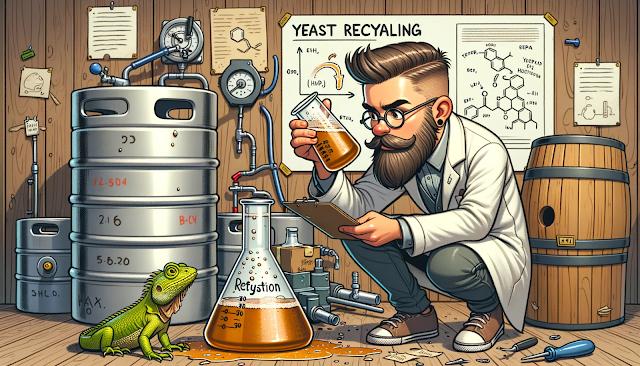Yeast is the unsung hero of the brewing world.
This microscopic powerhouse is the driving force behind fermentation, turning sugars into delicious beer.
But quality yeast doesn't always come cheap.
Enter the world of yeast recycling!
Why Recycling Yeast Makes Sense
For brewers who are on a tight budget or just environmentally conscious, recycling yeast from the trub presents a golden opportunity. Contrary to the belief of many, the sediment at the bottom of your fermenter is not just waste. Nestled within that layer is a treasure trove of active yeast cells, eager to embark on another fermentation journey.
Commercial breweries have long been in on this secret, consistently repitching yeast to maximize efficiency. So, what's stopping the homebrewer?
The Art of Yeast Washing
Washing yeast isn't about scrubbing them clean. It's a method designed to separate the viable yeast from the other remnants in the trub, primarily spent grains and hop particles.
Steps to Wash Your Yeast:
- Combine the trub with approximately 1500 ml of sanitized water in a container, preferably something like a conical flask.
- Allow the mixture to settle. As it does, you'll notice distinct layers forming, with the yeast and water creating a creamy layer above the heavier debris.
- Carefully pour off this creamy layer into a sanitized container, ensuring you leave the unwanted debris behind.
- Your freshly "washed" yeast is now ready for cold storage, where it can remain viable for several months.
The No-Wash, Direct Pitch Method
If washing sounds like a chore, there's a simpler route. Once your beer has been transferred out of the fermenter for bottling or kegging, you can:
- Add sterile water to the remaining trub to liquefy it.
- Stir this slurry and transfer it into sanitized storage containers.
- Seal and refrigerate.
When ready to use, if it's within a few weeks, pitch it directly. For older samples, consider rejuvenating them with some fresh wort and a bit of warmth.
Fresh Wort over Trub: A Shortcut?
Indeed, you could just introduce fresh wort directly over the trub. However, repeated cycles will result in a significant buildup of sediment. Thus, it's more efficient if done after a secondary fermentation. A gentle stir ensures the yeast is evenly distributed.
The Perks of Recycling Yeast
Recycling yeast isn't just about saving money. Introducing a larger volume of yeast cells to your wort can kickstart fermentation, leading to a more consistent product with fewer off-flavors or aromas.
The Longevity of Recycled Yeast
The lifespan of recycled yeast varies. Commercial setups often reuse yeast across numerous batches. For homebrewers, the key lies in meticulous sanitation and proper yeast care. The better these practices, the more extended and efficient the yeast's lifecycle.
Conical Fermenters: A Brewer's Best Friend
These unique fermenters simplify the process of accessing and removing trub. Thanks to their design, trub naturally settles at the cone's tip, making collection a breeze.
In conclusion, while yeast recycling requires a bit of extra effort, the rewards in terms of cost savings, efficiency, and beer quality make it a worthy endeavor for any serious homebrewer.

